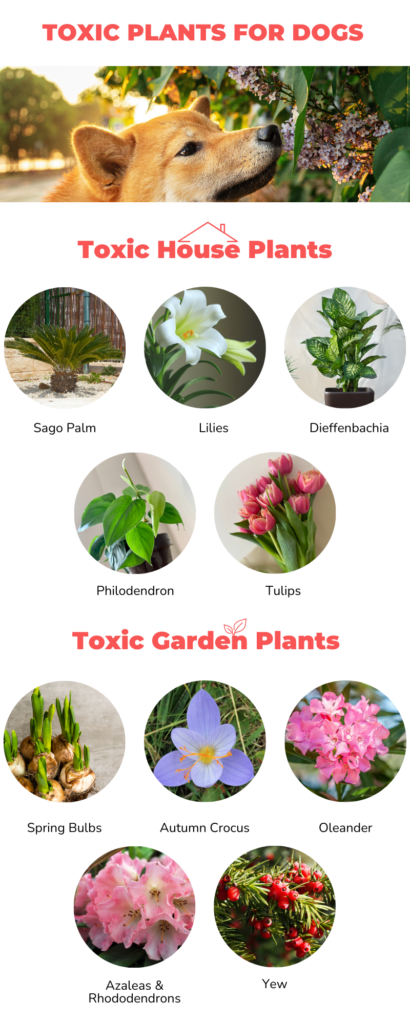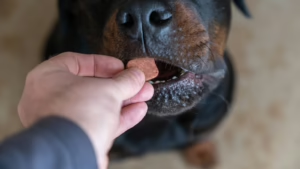Spring is in the air and gardens are blooming! Fresh flowers and plants can brighten up your home, and gardening is a favorite pastime for many. However, dogs happen to be curious creatures who explore the world first with their nose…and then with their mouths.
So if you have a green thumb, which plants are toxic, and which ones are safe for your dog?

Toxic House Plants for Dogs
When adding greenery to your home, it’s best to avoid these common houseplants that are toxic for dogs:
- Sago Palm: Sago palms may look like a tiny palm tree, but they’re extremely toxic to dogs and cats. While the entire plant is toxic, the seeds or “nuts” contain the highest concentration of toxins. The cycasin in this plant can cause liver failure, vomiting, diarrhea, seizures, and potentially death.
- Lilies / Lily of the Valley / Easter Lily: While not as toxic to dogs as they are to cats, lilies can cause an upset stomach and some species (lily of the valley) can cause serious heart problems. Ingestion leads to vomiting, diarrhea, decreased heart rate, and cardiac arrhythmias.
- Dieffenbachia (aka dumb cane or leopard lily): These are common indoor houseplants because they’re easy to grow. However, if your dog nibbles on these leaves the calcium oxalate crystals will cause a burning sensation to your dog’s mouth, lips, and throat.
- Philodendron: With heart shaped leaves and long vines, chances are you would recognize this houseplant. But beware, like Dieffenbachia, Philodendron contain the same calcium oxalate crystals that cause the symptoms described above.
- Tulips: These colorful blooms are a joy to have both indoor and outdoors when spring rolls around. While chewing on these leaves causes an upset stomach for dogs, the real danger is in the fresh-planted bulbs, which are hiding the most toxins.
Toxic Garden Plants for Dogs
- Spring Bulbs (Tulips & Hyacinths, Daffodils, Amaryllis, & Irises): All these flowers are toxic to dogs, with reactions varying based on how much they’ve consumed. The most common symptom is an upset stomach, but the most serious symptoms (drooling, tremors, breathing difficulties, abnormal heart rate) come from consuming the bulb itself.
- Autumn Crocus: Also known as naked lady or meadow saffron, this common garden flower is highly toxic to both dogs and cats. All parts of the plant are toxic due to a toxin called alkaloid colchicine. This toxicity causes severe stomach upset, gastrointestinal damage, kidney and liver damage, along with potentially fatal seizures.
- Oleander: This flowering shrub is a common landscaping plant that comes in shades of yellow, white, pink and red. While beautiful, all parts of this plant are toxic to both dogs and humans if ingested. Oleander contains glycoside toxins which interfere with the heart and can cause tremors, seizures and fatal heart abnormalities.
- Azaleas & Rhododendrons: These flowering shrubs are increasingly common, but all parts of these beauties contain grayanotoxins, and the reaction your pup gets depends on how much they’ve eaten. The most common sign is vomiting or diarrhea, but if your pup eats a lot of this toxin they can be left in a dangerous position.
- Yew: Yew is an evergreen that is extremely toxic to all species, including dogs and cats. All parts of the plant are especially toxic, and if ingested dogs can experience life-threatening symptoms such a difficulty breathing, seizures and in the worst cases, cardiac failure.
If you remember only a few plants from this list, remember to avoid Sago Palms, Autumn Crocus and Oleander. This is by no means a complete list of all the plants that are toxic to dogs. For a comprehensive list, visit ASPCA’s Animal Poison Control website.
Symptoms of Plant Poisoning in Dogs
Symptoms vary depending on the amount and type of plant ingested, but the symptoms below are a sign for alarm that your dog may have been exposed to a toxic plant.
- Vomiting and diarrhea (which may be mild to severe and may or may not contain blood)
- Excessive drooling
- Oral pain or difficulty swallowing
- Loss of appetite
- Seizures or tremors
- Itchiness or irritation
- Trouble breathing
- Irregular heartbeat (cardiac arrhythmias) indicated by weakness, staggering, shaking and mobility issues
What Should I Do If My Dog Has Ingested a Toxic Plant?
- Contact your veterinarian or closest 24-hour emergency vet. Symptoms may be delayed, but timing and early intervention improves treatment success. Note: The ReadiVet team does not provide emergency services outside of normal business hours. If you your pet may be experiencing a life-threatening emergency, please contact an emergency care facility near you.
- If you can’t reach a veterinarian right away, call the ASPCA’s Animal Poison Control Hotline (888-426-4435) or the Pet Poison Helpline (855-764-7661). They’re available 24/7 to evaluate exposure and consult you on the right course of action.
- Different plants require different treatments, so try your best to identify the plant your pet came in contact with and share this important information with your vet.
- Do not try to induce vomiting unless instructed to do so by your veterinarian or a pet poison control expert.
Having a dog doesn’t mean you can’t be a plant lover, too. You just need to be aware of which greens are good, and which greens are bad for dogs. As a rule of (green) thumb to protect your furry friends, always run a quick Google search to double-check any greenery you bring home is safe for dogs.
Spring and summer are full of sun and outdoor adventures, but it also comes with unexpected hazards for our furry friends. That’s why we offer mobile veterinary care for wellness exams, seasonal allergy shots, vaccinations and preventative medications.
Contact us today to schedule a wellness exam in the comfort of your home.




